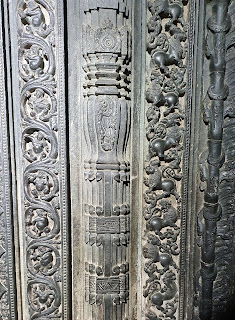Lakkundi
Lakkundi is situated deep inside Karnataka in the middle of a vast expanse of black cotton soil and lies just off the highway connecting Hampi and Badami. It is an overgrown and cluttered village with lousy, broken roads. Monsoon showers turn the pervasive filth pretty much unbearable.
But Lakkundi emphatically ought to be a lot more than a mere pitstop, let alone byepassed. There are literally dozens of ancient temples dotting the village; quite a few locals now know that these temples hold considerable interest to at least a few tourists and sometimes act as peddlars of historical gyan. I suspect many of the temples are in ruins now but one can't be sure - nasty weather limited us to a cursory exploration of only a couple of fairly intact specimens.
As opposed to the solid granite of Hampi and the sandstone of Badami, Lakkundi is about chloritic schist - a black stone with a subtle tinge of green that seems relatively easy to carve intricately and polish to mirror-like reflectivity. The heyday of the place was under the Kalyan Chalukyas who flourished around 1000 AD. Some restoration/enhancement of the Chalukya work was done by the Hoysalas a couple of centuries later.
While they are very much south Indian edifices, the Lakkundi temples, from some angles at least, are more reminiscent of Prambanan and Balinese temples than any Indian one.
As for the sculptural decoration, the closest Desi comparison would be to the Hoysala art of Somnathpur-Belur. The lathed and smoothed pillars in particular are very Hoysala.
Some of the intricate decorative work as well..
But in terms of sculpture proper, Lakkundi ranks way higher than the southern Chalukyan sites, at least in my book - for I haven't really been much of a fan of figures of this type
that almost "obliterate" the walls of temples at Somnathpur and especially, Belur.
Here are two narrative sculptures from Lakkundi (the really sad part: far too many figures on the temple walls have been defaced; not sure how much of the damage was deliberate and who did it):
Bhima locked in a duel with elephant-riding Bhagadatta:
a uniquely composed Gajasamhara - Siva has just torn off the hide of an elephant demon and is about to wrap it around himself.
I really loved this doorway:
Details of the decoration - with all those putti musicians among the vines. IMO, the workmanship deserves as much exposure as the glorious margins of the Book of Kells, nothing less!
Some more...
I can't resist adding a couple more pics...
A very Hoysala Brahma stands within a Jain temple on a pedestal better suited to a Shivalinga.
I conclude this brief note with a 'Half Vishnu' on display at an apology of a museum here - photography isn't allowed and this pic was taken before we were warned by the staff. I am sorry!
















0 Comments:
Post a Comment
<< Home